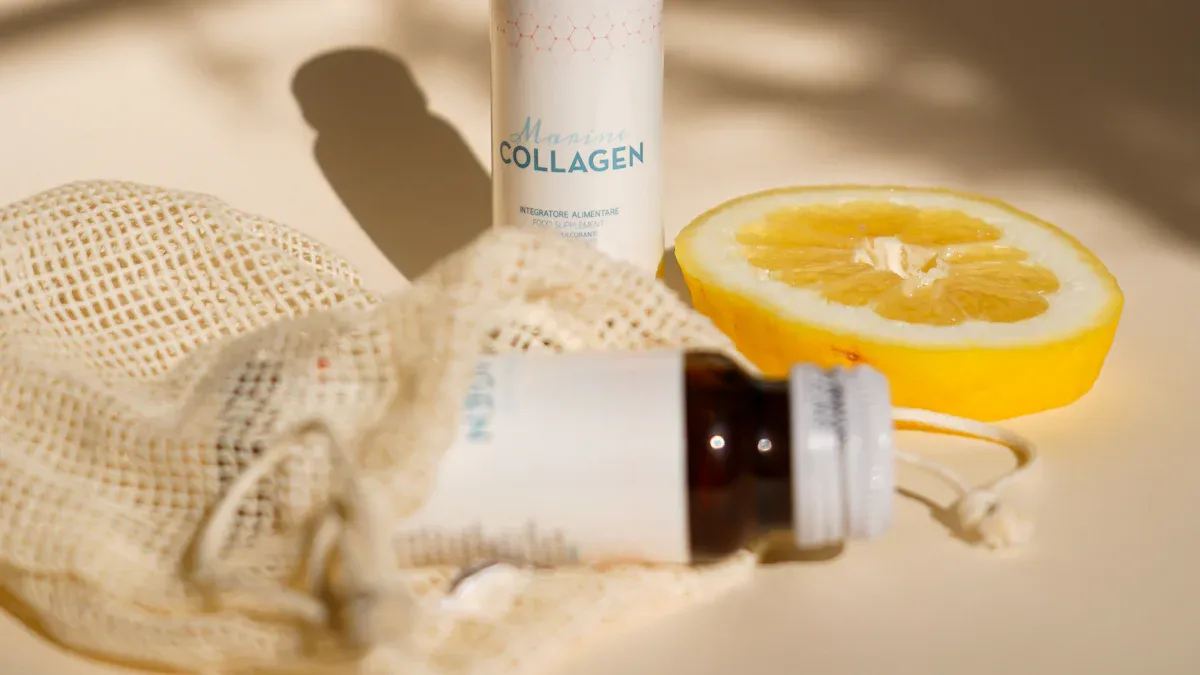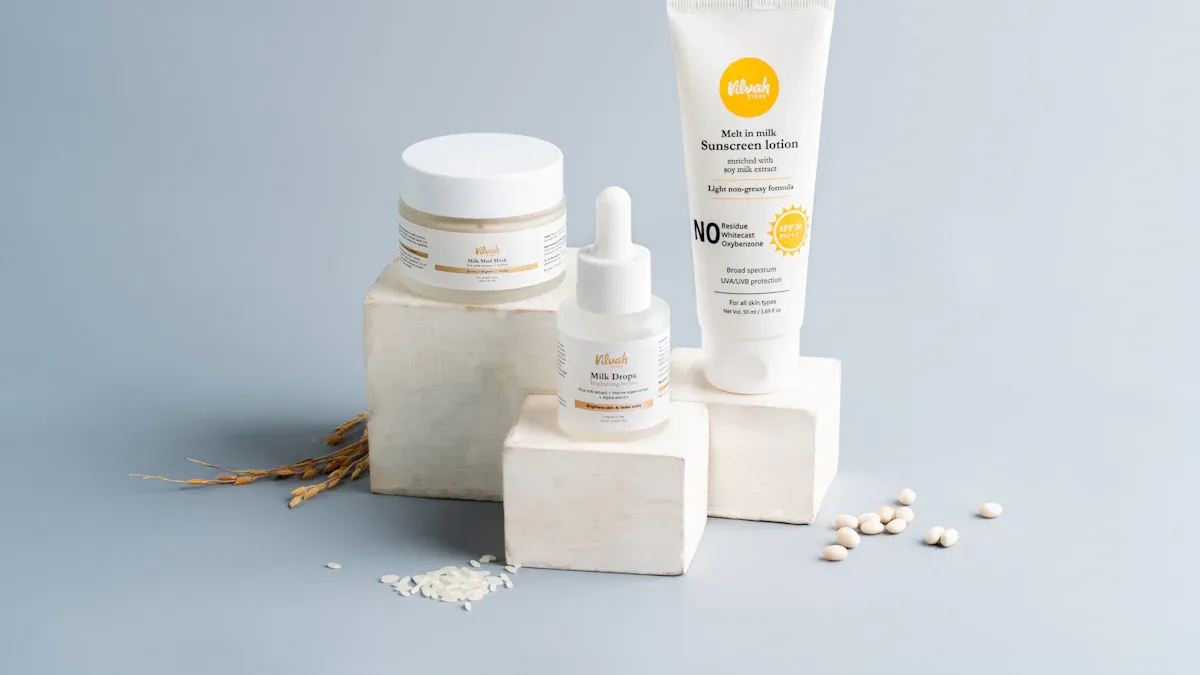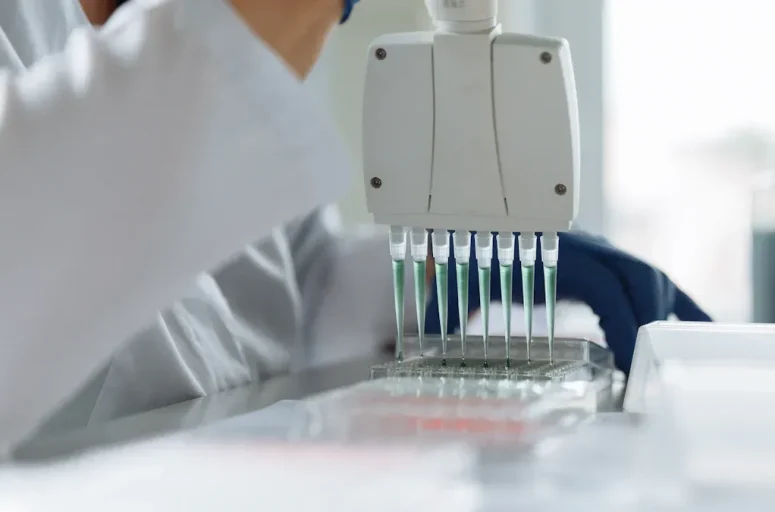
Transdermal nutrition is a new way to deliver nutrients. It sends nutrients straight into your bloodstream using patches. Unlike pills, these patches skip your digestive system. This helps avoid problems with absorption and works better. For example, vitamin patches give nutrients slowly over time. This stops big ups and downs like with pills.
Studies show patches avoid fighting for nutrients in your stomach. This makes them a good option for many people. More people are using them for personal health and prevention. But some still question if they really work as promised.
Key Takeaways
Transdermal supplements send nutrients through the skin, skipping the stomach for better absorption.
Vitamin patches are easy to use and great for busy people or those who dislike pills.
These patches slowly release nutrients, keeping steady levels in your body all day.
Transdermal methods work well for some nutrients like magnesium and vitamin D, but not all nutrients can pass through the skin.
Talk to a doctor before using transdermal supplements to make sure they are safe and right for you.
Patches can help people with stomach problems since they avoid the digestive system.
Even though they are handy, transdermal supplements should not replace eating healthy foods.
Be careful because supplements are not strictly checked by the FDA; always read labels and ask a doctor if they are safe.
What Is Transdermal Nutrition?

Definition and Concept
Transdermal nutrition means sending nutrients through your skin. These nutrients go straight into your bloodstream. This skips your digestive system, which can block absorption. By avoiding digestion, your body absorbs nutrients better. Magnesium and vitamin D work well through the skin. Studies show transdermal magnesium raises levels in deficient people. Vitamin D patches also improve blood levels more than pills.
This method skips first-pass metabolism. First-pass metabolism happens when the liver breaks down nutrients. Skipping this step makes delivery faster and more efficient. Transdermal methods are useful for vitamins, minerals, and other compounds.
Popular Forms, Including Vitamin Patches
Vitamin patches are a common type of transdermal nutrition. These patches stick to your skin and release nutrients slowly. They are easy to use and don’t need swallowing pills. Multivitamin patches give many vitamins and minerals at once. Other patches focus on one nutrient, like B12, magnesium, or CBD.
Vitamin patches are becoming more popular. In 2024, they made up 83.17% of market revenue. Multivitamin patches may grow by 15.5% from 2025 to 2030. This shows people want simple ways to add nutrients to their diet.
How It Differs from Oral Supplementation
Transdermal nutrition works differently than oral supplements. Pills go through your digestive system, where absorption can be affected. Patches deliver nutrients directly through your skin. This avoids problems like stomach acid or gut health issues.
Bioavailability is another difference. Transdermal delivery skips first-pass metabolism, which lowers pill effectiveness. For example, iron pills work better than patches for raising iron levels. But vitamin D patches increase levels faster than pills over eight weeks.
Oral supplements are still the most common choice. But transdermal methods help people with digestion or absorption problems. They also give nutrients steadily, keeping levels consistent in your body.
How Do Transdermal Supplements Work?
The Science Behind Skin Absorption
Your skin does more than protect your body. It also lets some nutrients pass through into your bloodstream. This depends on how easily the skin allows substances to enter. Nutrient molecules must be tiny to get through the outer skin layer, called the stratum corneum. Once they pass this layer, they move into deeper tissues and then the bloodstream.
Studies show this process works well for certain nutrients:
Knutsen et al. (2017) found vitamin D patches raised blood levels better than pills.
Shechter et al. (2017) showed magnesium patches improved low magnesium levels.
Hammell et al. (2016) reported CBD patches eased nerve pain without major side effects.
These studies prove transdermal methods can deliver nutrients effectively.
The Role of the Skin Barrier in Nutrient Delivery
The skin barrier protects your body but also blocks many substances. The stratum corneum, the top layer, stops harmful things but also slows nutrient absorption. To help nutrients pass through, transdermal supplements use enhancers like liposomes or nanotechnology. These tools make it easier for nutrients to get through the skin.
Thinner skin areas, like behind your ears or on your wrists, absorb nutrients better. Applying patches to these spots improves how well they work.
Nutrients Commonly Delivered via Transdermal Methods
Not all nutrients work well with transdermal delivery. The best ones are small enough to pass through the skin and provide clear benefits. Examples include:
Vitamin D: Helps bones and the immune system and absorbs well through skin.
Magnesium: Eases muscle cramps and helps with sleep when used in patches.
CBD (Cannabidiol): Reduces pain and swelling without upsetting the stomach.
These nutrients are great for transdermal use because they skip digestion and provide steady results.
Do Transdermal Supplements Actually Work?
Current Scientific Evidence and Research Gaps
You may wonder if vitamin patches really work. Research shows they skip the digestive system. This avoids first-pass metabolism and improves nutrient absorption. Your body absorbs nutrients better this way. But, this method works well only for some nutrients. Scientists still need to study more vitamins and minerals.
For example, magnesium and vitamin D patches show good results. However, there isn’t much data on nutrients like iron or calcium. Researchers also need to study how skin type or thickness affects absorption. Without more studies, it’s unclear if patches work for all nutrients.
Bioavailability: How It Compares to Oral Supplements
Bioavailability means how well your body uses nutrients. Transdermal supplements claim to have higher bioavailability than pills. They avoid stomach acid and enzymes that break down nutrients. For example, vitamin patches send nutrients straight through your skin.
But not all nutrients work better with patches. Magnesium absorbs well through the skin. Iron, however, works better when taken as a pill. This shows that each nutrient needs the right delivery method. Patches may release nutrients steadily, but pills are sometimes more effective.
Nutrient-Specific Effectiveness (e.g., Magnesium vs. Iron)
How well patches work depends on the nutrient. Magnesium is a great example. Studies show magnesium patches raise blood levels in deficient people. Vitamin D patches also work well, keeping levels steady in your body.
Iron, on the other hand, doesn’t absorb well through the skin. Pills are still the best way to fix iron deficiency. This proves patches aren’t perfect for every nutrient. You should choose the method that works best for your needs.
Testing and Regulation Challenges
Testing and rules for transdermal supplements face big problems. You might think all supplements are tested well before being sold. But that’s not true. Unlike medicines, supplements like patches don’t need FDA approval to be sold. This lack of strict checks raises concerns about safety and quality.
Fun Fact: The FDA treats supplements as food, not medicine. This means companies don’t have to prove their products work before selling them.
One problem is the small amount of research on these supplements. Some studies show good results, but they often use small groups or focus on nutrients like magnesium or vitamin D. These studies don’t always consider things like skin type or age, which can change how nutrients absorb. Without bigger studies, it’s hard to know if patches work for everyone.
Another issue is product quality. Since rules aren’t strict, companies can make big promises without proof. For example, a patch might say it gives 100% of your daily vitamins. But without proper testing, there’s no way to be sure. Sometimes, lab tests show patches don’t match their claims.
Here’s a simple table comparing drugs and supplements:
Feature | Drugs | Supplements |
|---|---|---|
FDA Approval Needed? | Yes | No |
Safety Tests Required? | Yes | No |
Proven Effective? | Yes | Not Always |
Also, there’s no standard way to test transdermal supplements. Different companies use different methods to make patches. This leads to different absorption rates, making it hard to compare products or trust their claims.
Benefits of Transdermal Supplements

Easy to Use and Painless
Transdermal supplements are simple and pain-free to use. Unlike pills, you don’t need to swallow them. Instead, patches stick to your skin and send nutrients straight into your bloodstream. This skips your digestive system, where stomach acid can lower pill effectiveness. By avoiding digestion, patches help your body absorb nutrients better.
These patches are also very handy. They are small, easy to wear, and perfect for busy people or travelers. You don’t need to remember multiple pills daily. Just put on one patch, and it works all day. Older adults who find pills hard to swallow also like this option. Multivitamin patches are becoming more popular, with growth expected by 15.5% from 2025 to 2030.
Tip: For better results, place patches on thin skin areas like wrists or behind ears.
Great for People with Digestive Problems
If you have stomach issues, transdermal supplements can really help. Problems like Crohn’s disease or irritable bowel syndrome make it hard to absorb nutrients from pills or food. Patches skip the digestive system, so your body gets nutrients directly.
This method also avoids stomach discomfort caused by some pills. For example, pills can cause bloating or upset stomachs, especially for sensitive people. Patches deliver nutrients without these problems. They also release nutrients slowly, keeping levels steady in your body.
Benefit | Description |
|---|---|
Skips Digestion | Avoids stomach issues, ensuring better nutrient absorption. |
Steady Nutrient Supply | Releases nutrients slowly into the bloodstream. |
Less Stomach Discomfort | Reduces bloating or nausea caused by pills. |
Fewer Side Effects Like Nausea
Pills can cause nausea or upset stomachs, especially if taken without food. Transdermal supplements avoid this by skipping the digestive system. This makes them a safer choice for people who get side effects from pills.
For those with health issues that block nutrient absorption, patches are a good alternative. They give vitamins and minerals without causing stomach problems. You also don’t need to take pills every day, making patches a simple and effective option.
Note: While patches lower side effects, they can’t replace healthy eating. Always try to get most nutrients from real foods.
Potential for Steady Nutrient Release
One great thing about transdermal supplements is their steady nutrient release. Unlike pills, which give nutrients all at once, patches work slowly. They release nutrients over hours, keeping your body supplied all day. This slow delivery helps keep nutrient levels stable in your blood.
For example, taking a vitamin pill can cause a quick nutrient spike. After that, levels drop fast. With patches, nutrients are absorbed slowly and evenly. This steady pace may help your body use them better.
Did You Know?
Nutrients like magnesium and vitamin D benefit from steady release. They support energy, muscles, and overall health.
Patches are also great for people who forget daily pills. One patch can last 8 to 24 hours, depending on the type. This makes it easier to stick to a routine.
Another benefit is better absorption. Slow delivery gives your body more time to use nutrients. This avoids wasting nutrients your body can’t absorb all at once. For example, vitamin C, a water-soluble vitamin, is often lost in large doses. Patches deliver smaller amounts over time to prevent this.
Still, not all nutrients work well with patches. Iron, for instance, absorbs better through pills. Always think about your needs and ask a doctor before using transdermal supplements.
Drawbacks of Transdermal Supplements
Lack of FDA Approval and Regulation
Transdermal supplements, like vitamin patches, aren’t approved by the FDA. Unlike medicines, supplements don’t need strict testing before being sold. This raises concerns about their safety and effectiveness. Some patches might not deliver the nutrients they promise, leading to mixed results.
Without strong rules, companies can make big claims without proof. This makes it hard for people to trust these products. Transdermal systems also have unique challenges, like sticking well and avoiding leaks. These issues show why better rules are needed.
Issue | Details |
|---|---|
Most transdermal systems lack cheaper alternatives. | |
Hard to test TDS effectiveness | Comparing how well different patches work is difficult. |
Product design challenges | Problems like leaks and poor adhesion need stricter standards. |
Since the FDA doesn’t approve these products, you can’t be sure they’re safe. It’s important to talk to a doctor before using them.
Variable Absorption Rates Across Individuals
Another problem with transdermal supplements is uneven absorption. Your skin blocks many substances, and absorption depends on skin type. Thin skin areas, like behind your ears, absorb nutrients better than thick areas, like your palms.
This means patches don’t work the same for everyone. Some people may get good results, while others may not. Other challenges include:
Only certain vitamins can pass through the skin.
Keeping vitamins stable in patches is tricky.
Nutrients don’t always release evenly.
Patches can only hold a few vitamins at once.
These problems make patches less reliable for getting nutrients. You might need to try different brands, which can be frustrating and take time.
Higher Costs Compared to Oral Supplements
Transdermal supplements often cost more than pills. Vitamin patches are seen as fancy products because they’re easy to use. But this convenience comes with a higher price. A pack of patches can cost much more than a bottle of vitamins.
Paying more doesn’t always mean better results. Absorption rates vary, and weak rules make quality uncertain. Advanced tech, like nanotechnology, also adds to the cost of making patches.
If money is tight, pills might be a better choice. Patches have benefits, but their value depends on how well they work for you.
Limited Proof for Long-Term Success
You might ask if vitamin patches work well over time. Sadly, there isn’t enough proof to say for sure. Most research on transdermal supplements comes from small studies or animal tests. These studies often show mixed results for certain nutrients. For instance, iron patches don’t work as well as pills. In people recovering from weight-loss surgery, patches didn’t fix nutrient shortages much. This makes their long-term reliability unclear.
Another issue is how uneven absorption can be. Things like nutrient size and your skin’s condition affect how patches work. Some nutrients, like magnesium, absorb better through the skin. Others, like calcium or iron, have trouble getting through the skin barrier. These differences make it hard to trust patches for steady nutrition over time.
The lack of testing rules adds more doubt. Different brands make patches in different ways, causing mixed results. Without better, long-term studies, it’s tough to know if patches can fully meet your nutritional needs.
Note: Always talk to a doctor before using vitamin patches for a long time.
Can’t Replace Healthy Eating
Even though patches are easy to use, they can’t replace healthy eating. A good diet gives your body many nutrients it needs to stay healthy. Patches can only provide a few nutrients. For example, they may deliver magnesium or vitamin D well, but they can’t give the variety of nutrients found in real food.
Here’s a table showing some limits of patches:
Limitation | Description |
|---|---|
Patches don’t offer a wide range of nutrients. | |
Uneven absorption | Nutrient absorption can differ a lot between people. |
Need for variety | A balanced diet gives many nutrients for good health. |
Your body needs more than just vitamins and minerals. It also needs fiber, antioxidants, and other helpful compounds from fruits, vegetables, and grains. Patches can’t provide these. Plus, eating food helps with digestion and gut health.
While patches can help with specific needs, they shouldn’t replace real food. Eating a balanced diet is still the best way to stay healthy.
Tip: Eat lots of colorful fruits and veggies to get more nutrients.
Are Transdermal Supplements Worth It?
Looking at the Pros and Cons
Deciding if transdermal supplements are right needs careful thought. A big advantage of patches is skipping the digestive system. This helps your body absorb nutrients better. Unlike pills, patches avoid stomach acid breaking nutrients down. They also work well for people with digestion problems. Patches release nutrients slowly, keeping levels steady in your blood.
But there are downsides too. The skin’s top layer, called the stratum corneum, blocks large molecules. This means not all nutrients can pass through the skin. Some people might get skin irritation from patches. Also, patches cost more than pills and may not work the same for everyone. Skin type and how you apply them can change how well they work.
Aspect | Transdermal Supplements | Oral Supplements |
|---|---|---|
Bioavailability | Higher, skips first-pass metabolism | Lower, affected by digestion |
Absorption Rate | Direct and efficient | Slower, depends on gut health |
Limitations | Skin issues, nutrient size matters | Stomach problems, uneven absorption |
Individual Considerations | Good for specific needs | May not suit those with gut issues |
Who Benefits Most from Transdermal Nutrition?
Some people may find transdermal supplements very helpful. If swallowing pills is hard or you have stomach issues, patches are a good choice. Conditions like Crohn’s disease or IBS make absorbing nutrients from food or pills tough. Patches skip digestion, delivering nutrients directly into your bloodstream.
Patches are also great for keeping steady nutrient levels. For example, people low in magnesium or vitamin D might benefit from slow nutrient release. Those with sensitive stomachs or nausea from pills may prefer patches. But patches don’t work for everyone. Their success depends on the nutrient and your body’s needs.
Patches avoid digestion problems, helping your body use nutrients better.
They keep vitamin levels steady, avoiding big ups and downs.
This method is useful for people with stomach or absorption issues.
Why Talk to a Healthcare Professional?
Before using transdermal supplements, talk to a healthcare expert. They can give advice based on your health and needs. A doctor or dietitian can check if patches are right for you. They’ll also suggest the correct dose and watch for medicine interactions.
Using patches correctly is important too. A healthcare provider can show you where to place them for the best results. They’ll also explain how long to wear them. Without proper guidance, patches might not work well. Regular check-ins can help adjust your plan and track progress.
Tip: Always ask a healthcare professional before starting transdermal supplements for safe use.
Transdermal supplements, such as vitamin patches, are an easy way to get nutrients. They send nutrients straight into your bloodstream, skipping digestion. This helps keep vitamin levels steady all day. Experts say patches are good for people with absorption issues. They avoid the digestive system and help your body use nutrients better. But how well they work depends on the nutrient and the person. Patches can help with certain needs but can’t replace healthy eating. Always talk to a doctor before using vitamin patches.
FAQ
What are transdermal supplements?
Transdermal supplements, like vitamin patches, send nutrients through your skin. They skip your stomach and go straight into your bloodstream. This avoids problems with absorption caused by stomach acid or gut issues.
Are transdermal supplements safe to use?
Most transdermal supplements are safe for many people. But they don’t have strict FDA rules. Always check the ingredients and ask a doctor before using them, especially if you have allergies or health problems.
Can transdermal supplements replace oral supplements?
No, transdermal supplements can’t fully replace oral supplements. They work well for some nutrients, like magnesium or vitamin D. But they don’t deliver all nutrients effectively. A healthy diet and oral supplements are still important.
How do I use a vitamin patch?
Put the patch on clean, dry, thin skin, like your wrist or behind your ear. Follow the instructions for how long to wear it. Don’t use it on irritated or broken skin.
Do transdermal supplements work for everyone?
No, they don’t work the same for everyone. Skin type, thickness, and the nutrient affect how well they absorb. Some people may get better results than others.
Are transdermal supplements expensive?
Yes, they usually cost more than pills. Making patches uses advanced technology, which raises the price. Think about your budget before choosing them.
What nutrients work best with transdermal delivery?
Nutrients like magnesium, vitamin D, and CBD absorb well through skin. Bigger molecules, like iron or calcium, don’t pass through skin easily. These work better as pills.
Should I consult a doctor before using transdermal supplements?
Yes, always talk to a doctor before using transdermal supplements. They can check if these products are right for you and make sure they won’t cause problems with medicines or health conditions.
Tip: Visit your doctor regularly to check if the supplements are helping you.

